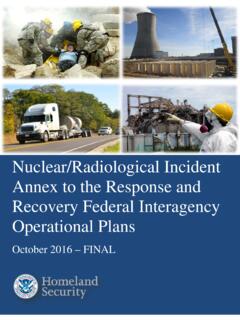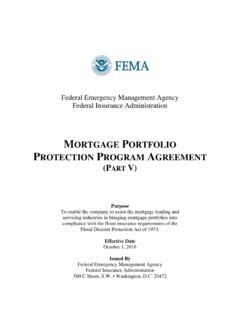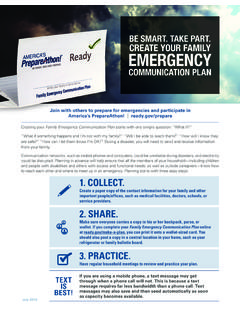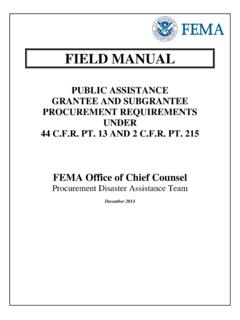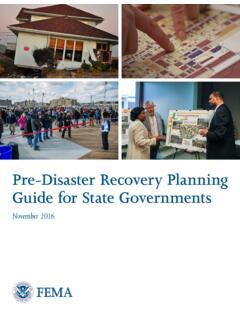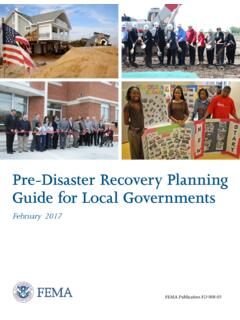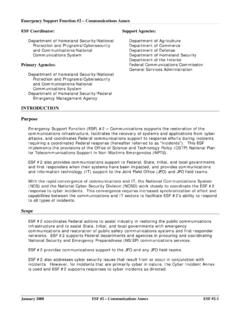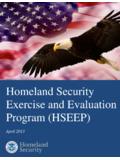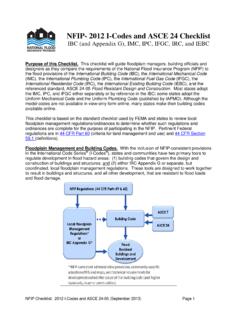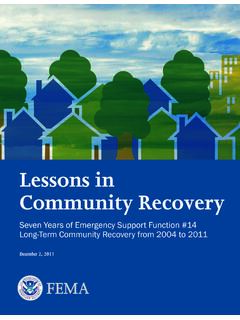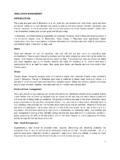Transcription of EMERGENCY SUPPORT FUNCTION ANNEXES: …
1 EMERGENCY SUPPORT FUNCTION annexes : introduction Purpose This section provides an overview of the EMERGENCY SUPPORT FUNCTION (ESF) structure, common elements of each of the ESFs, and the basic content contained in each of the ESF annexes . The following section includes a series of annexes describing the roles and responsibilities of Federal departments and agencies as ESF coordinators, primary agencies, or SUPPORT agencies. Background The ESFs provide the structure for coordinating Federal interagency SUPPORT for a Federal response to an incident. They are mechanisms for grouping functions most frequently used to provide Federal SUPPORT to States and Federal-to-Federal SUPPORT , both for declared disasters and emergencies under the Stafford Act and for non-Stafford Act incidents (see Table 1). The Incident Command System provides for the flexibility to assign ESF and other stakeholder resources according to their capabilities, taskings, and requirements to augment and SUPPORT the other sections of the Joint Field Office (JFO)/Regional Response Coordination Center (RRCC) or National Response Coordination Center (NRCC) in order to respond to incidents in a more collaborative and cross-cutting manner.
2 While ESFs are typically assigned to a specific section at the NRCC or in the JFO/RRCC for management purposes, resources may be assigned anywhere within the Unified Coordination structure. Regardless of the section in which an ESF may reside, that entity works in conjunction with other JFO sections to ensure that appropriate planning and execution of missions occur. Table 1. Roles and Responsibilities of the ESFs ESF Scope ESF #1 Transportation Aviation/airspace management and control Transportation safety Restoration/recovery of transportation infrastructure Movement restrictions Damage and impact assessment ESF #2 Communications Coordination with telecommunications and information technology industries Restoration and repair of telecommunications infrastructure Protection, restoration.
3 And sustainment of national cyber and information technology resources Oversight of communications within the Federal incident management and response structures ESF #3 Public Works and Engineering Infrastructure protection and EMERGENCY repair Infrastructure restoration Engineering services and construction management EMERGENCY contracting SUPPORT for life-saving and life-sustaining services ESF #4 Firefighting Coordination of Federal firefighting activities SUPPORT to wildland, rural, and urban firefighting operations January 2008 ESF annexes introduction ESF-i ESF-ii ESF annexes introduction January 2008 ESF Scope ESF #5 EMERGENCY Management Coordination of incident management and response efforts Issuance of mission assignments Resource and human capital Incident action planning Financial management ESF #6 Mass Care, EMERGENCY Assistance, Housing, and Human Services Mass care EMERGENCY assistance Disaster housing Human services ESF #7 Logistics Management and Resource SUPPORT Comprehensive, national incident logistics planning, management, and sustainment capability Resource SUPPORT (facility space, office equipment and supplies, contracting services, etc.)
4 ESF #8 Public Health and Medical Services Public health Medical Mental health services Mass fatality management ESF #9 Search and Rescue Life-saving assistance Search and rescue operations ESF #10 Oil and Hazardous Materials Response Oil and hazardous materials (chemical, biological, radiological, etc.) response Environmental short- and long-term cleanup ESF #11 Agriculture and Natural Resources Nutrition assistance Animal and plant disease and pest response Food safety and security Natural and cultural resources and historic properties protection and restoration Safety and well-being of household pets ESF #12 Energy Energy infrastructure assessment, repair, and restoration Energy industry utilities coordination Energy forecast ESF #13 Public Safety and Security Facility and resource security Security planning and technical resource assistance Public safety and security SUPPORT SUPPORT to access, traffic, and crowd control ESF #14 Long-Term Community Recovery Social and economic community impact assessment Long-term community recovery assistance to States, local governments.
5 And the private sector Analysis and review of mitigation program implementation ESF #15 External Affairs EMERGENCY public information and protective action guidance Media and community relations Congressional and international affairs Tribal and insular affairs ESF Notification and Activation The NRCC, a component of the National Operations Center (NOC), develops and issues operations orders to activate individual ESFs based on the scope and magnitude of the threat or incident. ESF primary agencies are notified of the operations orders and time to report to the NRCC by the Department of Homeland Security (DHS)/Federal EMERGENCY Management Agency (FEMA) Operations Center. At the regional level, ESFs are notified by the RRCC per established protocols. ESF primary agencies notify and activate SUPPORT agencies as required for the threat or incident, to include SUPPORT to specialized teams.
6 Each ESF is required to develop standard operating procedures (SOPs) and notification protocols and to maintain current rosters and contact information. ESF Member Roles and Responsibilities Each ESF Annex identifies the coordinator and the primary and SUPPORT agencies pertinent to the ESF. Several ESFs incorporate multiple components, with primary agencies designated for each component to ensure seamless integration of and transition between preparedness, response, and recovery activities. ESFs with multiple primary agencies designate an ESF coordinator for the purposes of preincident planning and coordination of primary and supporting agency efforts throughout the incident. Following is a discussion of the roles and responsibilities of the ESF coordinator and the primary and SUPPORT agencies. ESF Coordinator The ESF coordinator is the entity with management oversight for that particular ESF.
7 The coordinator has ongoing responsibilities throughout the preparedness, response, and recovery phases of incident management. The role of the ESF coordinator is carried out through a unified command approach as agreed upon collectively by the designated primary agencies and, as appropriate, SUPPORT agencies. Responsibilities of the ESF coordinator include: y Coordination before, during, and after an incident, including preincident planning and coordination. y Maintaining ongoing contact with ESF primary and SUPPORT agencies. y Conducting periodic ESF meetings and conference calls. y Coordinating efforts with corresponding private-sector organizations. y Coordinating ESF activities relating to catastrophic incident planning and critical infrastructure preparedness, as appropriate. Primary Agencies An ESF primary agency is a Federal agency with significant authorities, roles, resources, or capabilities for a particular FUNCTION within an ESF.
8 ESFs may have multiple primary agencies, and the specific responsibilities of those agencies are articulated within the relevant ESF Annex. A Federal agency designated as an ESF primary agency serves as a Federal executive agent under the Federal Coordinating Officer (or Federal Resource Coordinator for non-Stafford Act incidents) to accomplish the ESF mission. When an ESF is activated in response to an incident, the primary agency is responsible for: y Supporting the ESF coordinator and coordinating closely with the other primary and SUPPORT agencies. y Orchestrating Federal SUPPORT within their functional area for an affected State. January 2008 ESF annexes introduction ESF-iii y Providing staff for the operations functions at fixed and field facilities. y Notifying and requesting assistance from SUPPORT agencies. y Managing mission assignments and coordinating with SUPPORT agencies, as well as appropriate State officials, operations centers, and agencies.
9 Y Working with appropriate private-sector organizations to maximize use of all available resources. y Supporting and keeping other ESFs and organizational elements informed of ESF operational priorities and activities. y Conducting situational and periodic readiness assessments. y Executing contracts and procuring goods and services as needed. y Ensuring financial and property accountability for ESF activities. y Planning for short- and long-term incident management and recovery operations. y Maintaining trained personnel to SUPPORT interagency EMERGENCY response and SUPPORT teams. y Identifying new equipment or capabilities required to prevent or respond to new or emerging threats and hazards, or to improve the ability to address existing threats. SUPPORT Agencies SUPPORT agencies are those entities with specific capabilities or resources that SUPPORT the primary agency in executing the mission of the ESF.
10 When an ESF is activated, SUPPORT agencies are responsible for: y Conducting operations, when requested by DHS or the designated ESF primary agency, consistent with their own authority and resources, except as directed otherwise pursuant to sections 402, 403, and 502 of the Stafford Act. y Participating in planning for short- and long-term incident management and recovery operations and the development of supporting operational plans, SOPs, checklists, or other job aids, in concert with existing first-responder standards. y Assisting in the conduct of situational assessments. y Furnishing available personnel, equipment, or other resource SUPPORT as requested by DHS or the ESF primary agency. y Providing input to periodic readiness assessments. y Maintaining trained personnel to SUPPORT interagency EMERGENCY response and SUPPORT teams. y Identifying new equipment or capabilities required to prevent or respond to new or emerging threats and hazards, or to improve the ability to address existing threats.
